Well the summer has come and gone and after 9 blogs, I am ready for the big finale- Blog number 10. I did tell you when I started I was going to give you ten blogs over 2 months with multiple protocols to be published online and now we are at the end. So, what shall we talk about today, you want to know about my love of teenage mutant turtles, maybe my enjoyment of dinoriders (look it up, it’s a classic dinosaur cartoon series from the 80s). Nope, today I will go out on a high, and tell you about one of my true passions. The Pamplemousse, otherwise affectionately known as the grapefruit. And not just any grapefruit, but the ruby red Pamplemousse.
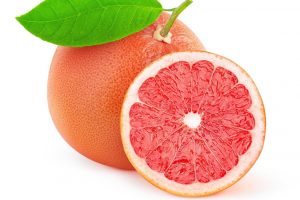 For 17 years, I eat my lunch like clockwork, every day after noon and the Pamplemousse is my midday fruit (I am a man of routine). To me, it’s soooo much better than an orange, and it has everything you want in a fruit, people have debated the merits of an orange with me, but I just don’t get the same joy. Fruitiness, sweetness, loveliness, all in one fruit. And it can be eaten all year long, not just summer. So, there you have it, you want to get on Tom’s good side, eat a Pamplemousse with him, and also bring some chocolate for me to consume.
For 17 years, I eat my lunch like clockwork, every day after noon and the Pamplemousse is my midday fruit (I am a man of routine). To me, it’s soooo much better than an orange, and it has everything you want in a fruit, people have debated the merits of an orange with me, but I just don’t get the same joy. Fruitiness, sweetness, loveliness, all in one fruit. And it can be eaten all year long, not just summer. So, there you have it, you want to get on Tom’s good side, eat a Pamplemousse with him, and also bring some chocolate for me to consume.
Now, what does it have to do with the science topic of the day, well nothing in fact, except its 3D in shape and is great, just like 3D neuronal organoids, or what some refer to as “Minibrains”. For years we worked in flat two dimensions with iPSC-derived neurons (and we still do). But, it was really only after Nguyen-Vi Mohamed joined that we got some technicolor and added an extra dimension to our lives. She says, Tom lets put a shaker in an incubator, and see if we can make brain organoids. I say sure, why not, lets try it, and two years, 10,000 organoids later we have truly become immersed in all things 3D neuronal organoid. Yes, we are still pretty new, but we have some cool things going on, and we are happy to share how we make our organoids, to share histology slides if needed for testing antibodies, and have published our SOP for everyone to see the methods we adapted in our group. In particular, as Parkinson’s disease is one of our big focus areas, the first organoids we made were midbrain organoids, organoids that are enriched in dopaminergic neurons.
So, you sit there, and think, man its must be hard to make these organoids, well you know something, it is, it really is…..
I kid I kid. Anyone can make them, all you need is an incubator and a shaker inside the incubator, and a little sprinkle of magic knowhow. 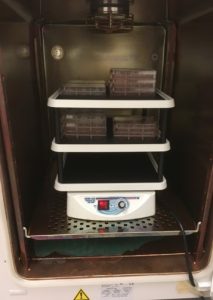
You want low speed constant shaking, to ensure good oxygenation and nutrient distribution, keep the little organoids happy. These minibrains grow to 4mm in size, no more, sometimes less depending on how they form at the start.
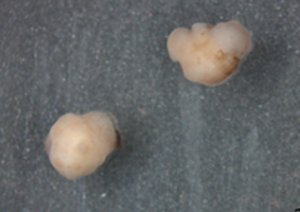
And the first step is the most important, which is the iPSCs you use. Go back to my earlier blog, and you will see my points on iPSC quality control, this is crucial here, you need the best of the best cell-wise, otherwise your organoids will have problems and may not grow normally. This can manifest in the very earliest stages when you create a single cell mix of iPSCs to put in a low attachment U-bottom dish where it forms an embryoid body (EB). This is the seed for the minibrains, and you want it uniform and spherical (left image). But sometimes, things go awry and you get extra buds, extra pieces (right image- like mickey mouse) and this can all lead to organoids that vary in size and shape.
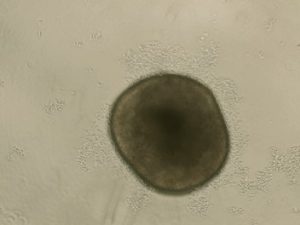
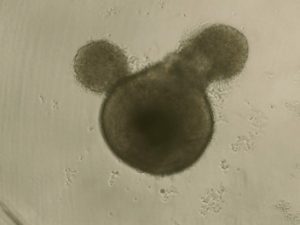
Another crucial step for making the midbrain and cerebral organoids for us is embedding in matrigel. We encase these organoids in this gelatinous structure, for 1 week once EBs are formed, and then transfer into the shaker. And from this point on, its all about looking, and nurturing. During a week, we do three media changes to ensure the nutrients are replenished, and these organoids can be maintained for as long you want. Some batches we grow for 15 days, others 30 days, 3 months, 6 months and our oldest was 18 months. Other groups have gone as high as 4 years, so imagine being a graduate student and waiting on your organoids to be ready in 48 months.
Organoids can be used for all manner of things, from being dissociated and analyzed by flow cytometry, to being lysed for proteomic analysis, to being fixed, embedded and sectioned for imaging studies. We have embedded in either parafilm or OCT and sectioned these 3D structures on a microtome or cryostat respectively. This is tricky to do, but it simply requires some practice, as organoid tissue is different to mouse brain tissue, as its much softer and less rigid. But when you get it right, you get some great images of the neurons in the neuronal organoids themselves (Midbrain organoid-Left image; Cerebral organoid- Right image)
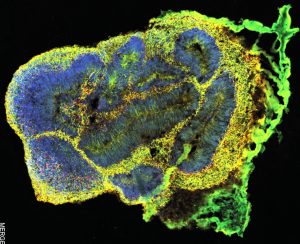
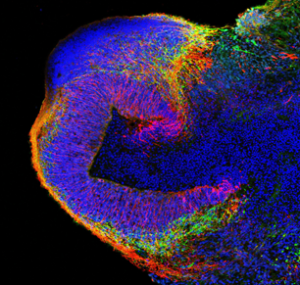
Neuronal organoids are new, but are here to stay, and to date us and others have barely scratched the surface of their potential, which makes it even more exciting to see what we can learn from them about how neurons develop, how the brain might function and how a disease might occur.
Well I hope you enjoyed all the blogs, it was my way of discussing science and doing it with humor. And I hope I shed a light on what we are doing in my group. What started as a small rag tag group of three people in the iPSC/CRISPR platform, has now transformed into what we now call The Neuro’s Early Drug Discovery Unit (EDDU). We are still the same group as we were yesterday, but the new name reflects the diversity of activities we have ongoing and the exciting work we are undertaking as we look to do the early discovery work with both academics and industry in the quest for new drugs and therapies. Developing new therapies for CNS disorders is challenging and we hope to contribute something to finding new drugs that might one day soon enter the clinic.
I have one of the most committed and best bunch of people anyone could work with, and while this blog helped introduce you to me, I hope you will check out our new website, where you will be introduced to each and every one of them. They are the reason I get to write my blogs, and who do all the cool science I tell you all about. So, come check out the new website, learn more about us:
- Meet the team and learn what makes them tick
- Find all our SOPs and publications we have published, and keep an eye out for new SOPs, publications, and software that will be added over the next year
- Learn about the facilities we have to help you with your projects, including our automation platform and our FACs facility
- Hear about our history.
- Get involved with our group, if you think we can help you, please contact us, the blogs and SOPs give you a flavor of what we have to offer, but we are happy to discuss all kinds of projects and ways to help researchers and others like yourself.
I also want to say a special thanks to a few people for helping to build this website: Iain, Vanessa, Trisha, Anthony, Lenore, Kristiana and her team. They built it from the ground up and dealt with me on a daily basis, which is not an easy task. I am quite curmudgeonly. So thank you for all the hard work and effort you put into this.
Well, I hope you enjoyed reading my summer blog as much as I enjoyed writing it. But fear not, this is not my last post, there will be more, just not every week, likely every 2-4 weeks. Further posts are planned in October when I will be putting our two posters online that we are presenting at the Society for Neuroscience (SFN) meeting. So stay tuned for more.
Don’t be a stranger, grab a Pamplemousse and come say hi, I will even teach you my secret technique for peeling it within 60 seconds, this is not something I put in a blog or SOP, top secret stuff.

I really enjoyed all the blogs, so sad they are done. Could it be possible to do a winter blog? science never rest. Thank you so much for sharing in such a different/funny way. Cheers.
Thanks ANna, I appreciate the comment, and its not the end. There will more blogs coming, just not as often the summer. But keep an eye on this space for more to come.
Your content is very valuable. I highly appreciate to this content. It is a very nice article.